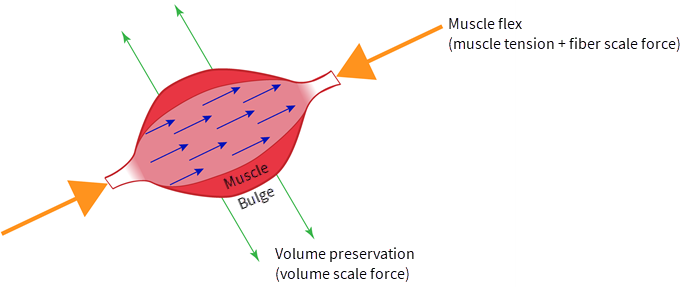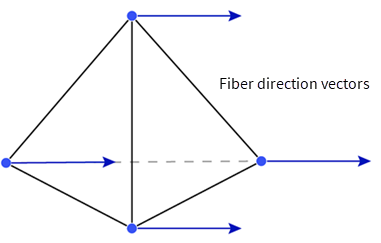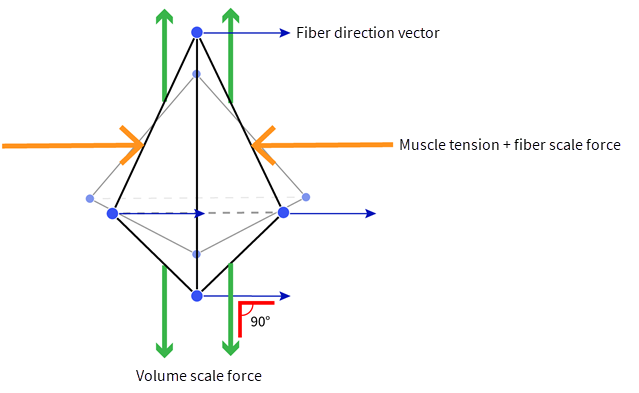| On this page |
Muscle fiber scale force & muscle tension ¶
Muscles respond to a stiffness force along their local axes to produce an effect that is similar to muscle contraction. We refer to this action as fiber scaling. Since muscles are assigned a relatively high volume preservation stiffness by default, when fiber scaling is applied along their local axes, a volume-preserving bulging occurs perpendicular to these axes.
The main attributes that contribute to the fiber scaling action are:
-
muscletensionapplies fiber scaling to muscles and thereby activates them, and you can animate it from theMuscle Flex SOP node.
-
fiberstiffnessprovides the fiber scale force or strength for the fiber scaling, and you can adjust it with the Fiber Strength parameter on theMuscle Properties SOP.
-
materialWvector attribute controls the orientation of the local axis, and it can be groomed interactively using theFiber Groom SOP node.
-
fibervolumescaleboosts the volume preservation response when fiber scaling takes effect, and you can adjust it with the Fiber Volume Scale parameter on theMuscle Properties SOP.



Fiber scaling varies over the different regions of a muscle. Areas designated as tendon regions in the
Muscle Properties SOP node will reduce the Fiber Strength, while the regions in the belly of the muscles will receive the full effect of the fiber scale force.
Important Note
Ultimately, the stiffness and responsiveness of fiber scaling actions are controlled by a combination of all the fiber parameters on the
Muscle Properties SOP.
Volume scale or shrinkage ¶
The
Tissue Properties SOP and
Skin Properties SOP nodes have parameters that control tissue and skin shrinkage. In their rest positions (
tpose attribute), the tissue, core, and skin record a rest volume and rest shape for each primitive in their geometries. Over the course of a simulation, the rest configuration can be modified relative to its initial state.
You can use the scale values for the rest shape and volume to adjust this rest configuration and create a shrink-wrapping effect that causes tissue and skin to pull inward and tighter against internal muscle and bone objects. By balancing the interplay between core, tissue solid, tissue surface, skin solid, and skin surface rest scales, you can achieve a variety of different tissue looks for your Muscles & Tissue simulation. For example, shrinking tissue tetrahedrons while expanding surface triangles can contribute to additional buckling over a tissue’s surface.
Sliding ¶
You can achieve a much more believable simulation if you apply sliding constraints to its attachments. With sliding constraints, surfaces and muscle objects are allowed to stay attached to internal geometry while having the freedom to slide the point of attachment relative to the initial state. Conversely, you can also use too much sliding to produce effects like muscles that flop every which way and tissue that oozes off the bone like a viscous fluid.
You can control the sliding for tissue and skin exterior surfaces (tissue surface and skin surface) with the Slide Rate and Slide Distance parameters on the
Tissue Properties SOP and
Skin Properties SOP nodes. Slide Rate affects the amount of change a re-projected target location is allowed to contribute to each time step during a solve. A Slide Rate of 1.0 allows a re-projection of a target attach location to update fully every time step, while a fractional slide rate only takes a percentage of the updated location vector. For more information on Vellum slide constraints, see Sliding Constraints.
| See also |